Top News
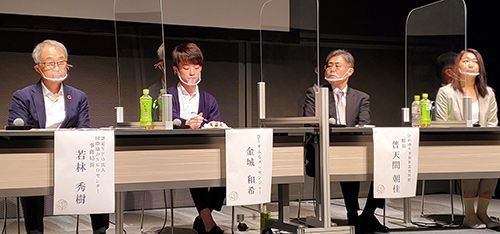
November 22, 2020 Ryukyu Shimpo
(Tokyo) On November 21, the “Peaceful Symposium,” organized by the Okinawa Prefectural Government, was held at the Tokyo International Forum to convey the “spirit of Okinawa” and its wish for peace to all of Japan. At the panel discussion, one panelist expressed worry that now, 75 years after the end after the Pacific War, “this very day might be looked back on as part of the pre-war.” The panelists proposed ideas for protecting peace, including the need for strategies to promote free debate and peace education and the need to respect diversity.
Chokei Futenma, director of the Himeyuri Peace Museum, stated, “I do not believe that Japan has been at peace for the past 75 years since the end of the war,” citing the ceaseless accidents and crimes by people connected to the U.S. military in Okinawa even after the war. He emphasized that “it is because those who experienced the war have spoken up about the tragedy it causes” that nonetheless war has not broken out in Japan during that time. He also said that “those who experienced war feel a sense of crisis” concerning changes in the environment surrounding peace and military armament in Japan and surrounding countries, and spoke of the necessity of passing down understanding of the war experience to younger generations.
Akiko Yamamoto, associate professor in the Faculty of Humanities and Social Sciences at the University of the Ryukyus, discussed a project carried out mainly by students involving data-based comparison of civilian suffering during the war in the Battle of Okinawa, in Hiroshima and Nagagasaki where the nuclear bombs were dropped, in Tokyo, and in other places, as an endeavor to promote peace education now that there are fewer and fewer war survivors. She cited “paternalism” in peace education and news reporting as an obstacle to spreading peace, and stated, “if we rely on the conventional model, we won’t reach the generations that need to know this information.”
Hideki Wakabayashi, director of the Japan NGO Center for International Cooperation (JANIC), which won the 10th Okinawa Peace Prize this year, discussed the SDF deployment to Iraq and stated, “it is said that Japan was at peace” for the 75 years since the end of the war, but “[Japan] aided in warfare.” He recalled his own experience at a private company, labor union, and governmental organization and said that although “each sector [appears to have] the correct logical structure,” the assertions made by each did end up leading to war in the past, and stated that “we need a mechanism for citizens to stand up and think and speak about whether [the direction we’re taking] is the right one; for each individual’s voice to serve as an engine for driving change in society.” Kazuki Kinjo, who has been appointed a “Peaceful Messenger” of Okinawa Prefecture having the role of spreading the wish for peace, explained that disputes arise from differences with others and stated, “understanding of diversity is important for building peace.”
Freelance announcer Michiko Sadoyama served as moderator of the discussion.
(English translation by T&CT and Sandi Aritza)
Go to Japanese

November 26, 2020 Ryukyu Shimpo
By Ikue Asato
On November 5, staff of the Ogimi Village Social Welfare Council (chaired by Tetsuo Shimada) and local social welfare workers visited the homes of two centenarians, Tsuru Maeda, 102, of Oshikawa Ward and Hatsu Miyagi, 103, of Yako Ward, in Ogimi Village.
Every fiscal year, “Ogimi mayors” participate in the “social welfare worker for a day” event and visit the homes of the elderly in each district (which are former elementary school districts.) However, as a precaution against the novel coronavirus pandemic, the mayoral event was canceled. The social workers independently organized the visits this year, entertaining the elderly and their families with music and dancing.
Both Maeda and Miyagi clapped along to the songs and said, “I’m overjoyed. I’m glad I lived to see this!”
Social worker Kazuyo Izena, 58, said with a smile, “The two are ageless. We were the ones energized by the visit.”
(English translation by T&CT and Monica Shingaki)
Go to Japanese
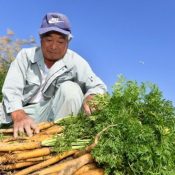
November 26, 2020 Ryukyu Shimpo
As of November 25, due to chill as a result of a high-pressure system moving in from the Eurasian continent, clouds have spread. However, in the Okinawa region the weather has mostly been fair. In Kitahama, Nakagusuku Village, which is known for being the area in which the best Okinawa island carrots are grown, the harvest of yellow island carrots is beginning.
Seijun Noha, 83, with a smile, said, “There has been harsh weather this year, but without fail we have watered in the morning and evening, and [the carrots] have been able to grow adequately.” The Nakagusuku Village Island Carrot Day will be held on December 12 to celebrate the time between December and February that is ideal for harvesting island carrots.
(English translation by T&CT and Erin Jones)
Go to Japanese

November 26, 2020 Ryukyu Shimpo
Okinawa City – Kina Farm in Ikehara, Okinawa City, which had to cull 3,012 pigs in January this year after being hit with classical swine fever (CSF), is undertaking a new challenge as part of their rebuilding process. With a goal of spreading awareness about eating locally, the farm opened Kinner’s food truck in September. Shinobu Kinna, 38, a representative for the farm, pleaded, “We don’t want people to forget about CSF,” calling for Okinawans to consume locally produced food.
Kinna saw the extermination of all of the pigs she had raised herself. In order to not forget about the CSF pandemic that hit her farm, she wears a pendant that says “January 2020” marking the outset of the disease, which she wears at all times. “The outbreak is burden I will carry with me for the rest of my life. I vow to definitely rebuild.” In August we started raising sows again, and currently we are up to 64 pigs. They are looking to start shipping pigs in the autumn of 2021.

The “Gochiso-sando,” made using locally sourced ingredients, and the food truck’s original drinks.
As part of the rebuilding process, they came up with the idea of the food cart offering food made using their pork and other locally sourced ingredients. “We think that because we have a place to offer the food that we do our best,” she said encouragingly. With help from local groceries and restaurants, they are selling and sandwiches with additive-free bread, and original drinks. Chef Satoshi Shiohira, 36, puts together dishes using ingredients like grilled pork and fermented vegetables, brining out the flavors of each of the ingredients.
The outbreak of CSF highlighted the importance of buying locally and supporting the farmers who produce the food we eat. “If buying locally produced food can create a support structure for local farmers, it can lead to fostering new farmers. We want Okinawans to learn about the makers of their food, and to enjoy food made with local ingredients.” This idea led them to name their sandwich the “Gochiso-sando” (sandwich made from the land). The food truck will travel all around Okinawa, and they hope it will lead to raising awareness about consuming locally produced food.
Currently, the food truck operates every Friday, Saturday, and Sunday at Urumarche in Uruma as their base of operations, making their rounds throughout the prefecture. In December, they also plan to start setting up shop in the southern part of Okinawa’s main island as well. For details, you can visit Kinner’s Instagram account.
(English translation by T&CT and Sam Grieb)
Go to Japanese

November 21, 2020 Ryukyu Shimpo
By Kenichi Muraishi
Zamami, Aka Island – Just before sunset on November 4, a lone black-faced spoonbill was spotted on Aka Island. The black-faced spoonbill is a familiar bird at the Manko tidal flat in Naha or the Triangle Pond, which is a detention basin in Tomigusuku.
Although sightings of these migratory heralds of winter were rare in the past, over the last 5-6 years, sightings of the birds even outside of their wintering term are becoming more common. It is possible that the birds have come to Aka Island in the past and there is simply no record of it.
On this occasion, it is thought that the bird was carried to Aka Island because of Tropical Storm Atsani, cold air coming in from the Asian continent, and a strong north wind. The Kerama Islands, which include Aka Island, are a designated National Park and registered under the Ramsar Convention.
(English translation by T&CT and Ellen Huntley)
Go to Japanese

November 21, 2020 Ryukyu Shimpo
Ginoza – Ventriloquist and Okinawa Native Ikkokudou gave a guest lecture at Ginoza Junior High School November 13. He also performed some ventriloquy, and talked about how he became a ventriloquist, and how important it was to have a goal to work towards.
Ikkokudou said that his first time seeing a ventriloquist was on TV when he was a junior high school student, while watching a female police officer talk about traffic safety using ventriloquy. He only really started doing it in earnest when he was 28. He told the students that his dream transitioned through being a professional baseball player and actor, stressing, “When your dreams change, it is not a setback, it is progress. What you did up until that point was certainly not a waste.”
He said that in junior high school he had a gloomy personality, but that once he got to high school he began to act more cheerful.
When he had his eyes set on becoming an actor, he would imitate the teachers, and was told, “He was good at capturing people’s characteristics. He said, “When you have a dream, it is important to think about it yourself and move forward.”
The speech was given to 170 first and second-year students. Second-year student Yuki Zukeyama gave her impression of hearing Ikkokudou’s story of becoming a ventriloquist, saying, “All of the things he had to study to figure out how to make different sounds and even sing without moving his mouth is impressive.”
(English translation by T&CT and Sam Grieb)
Go to Japanese

November 20, 2020 Ryukyu Shimpo
The Tokyo-based Association for Corporate Support for the Arts (Kigyo Mécénat Kyogikai “KMK”), led by President Motoki Ozaki, held its 2020 Japan Mécénat Awards Ceremony in Tokyo on November 20. The Mécénat Awards honors corporate activities that promote the arts and culture, contributing to a richly creative society (Mécénat). This year, the Ryukyu Shimpo-sponsored Ryukyu Classical Performing Arts Competition (Ryukyu Koten Geino Konkuru) and the Ryukyu Classical Performing Arts Festival (Ryukyu Koten Geinō Sai) were awarded the Mécénat Award for Excellence (Heart of Ryukyu Ichimadin Award [ichimadin: Okinawan for ‘always’]).
One recipient of the Grand Mécénat Award, five recipients of the Awards for Excellence, and one recipient of the Award Granted by the Commissioner for Cultural Affairs were selected out of the 93 companies and organizations conducting 165-mécénat activities nationwide. Ryukyu Shimpo was recognized for its long-standing efforts to preserve Okinawa’s traditional performing arts and expand its support by promoting local arts and training the younger generation.
Ryukyu Shimpo President Yasutaka Hanashiro commented, “[We are] glad we continued [this endeavor] for over half a century. The performers and the numerous staff that supported those artists made this [achievement] possible, and we are elated. This recognition encourages us to elevate the performing arts further and to serve as a bridge within Asia through the power of culture and performing arts.”

Ritsuko Ashimine, a performer and representative of the Ryukyu Classical Performing Arts Competition Office, performing the kagiyade-fuu at the 2020 Japan Mécénat Awards Ceremony in Tokyo, on November 20.
At the awards ceremony, Ritsuko Ashimine, a Ryukyu dance performer and representative of the Ryukyu Classical Performing Arts Competition Office, detailed the various mécénat activities and elegantly performed the kagiyade-fuu.
Natsuko Hagiwara, professor at Rikkyo University and an Mécénat Awards judge, said, “All the [mécénat] activities recognized today encourage the children of the future generation. Corporate mécénat activities offset cultural poverty; I believe the awardees will continue to do spectacular work.”
The Grand Mécénat Award was awarded to the Kajima Foundation for the Arts. The Awards for Excellence was awarded to Ryukyu Shimpo, Andersen Institute of Bread & Life, Onizuka Denki Koji, and the Sony Music Foundation. The Award Granted by the Commissioner for Cultural Affairs was awarded to Shiseido.
(English translation by T&CT and Monica Shingaki)
Go to Japanese
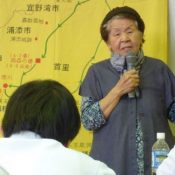
November 15, 2020 Ryukyu Shimpo
At 10:33 p.m. on November 12, Toshie Asato, who was the oldest living person speaking about her experiences of the Battle of Okinawa in Okinawa and who served as the model for the film “GAMA: Getto no hana (GAMA: Shell ginger flowers)”, died of thyroid cancer at a residence for the elderly in Kitanakagusuku. She was 99 years old. Her hometown was Kitanakagusuku.
During the Battle of Okinawa, Asato lost 11 family members, including her husband and two children. She began her activities speaking about her experiences in 1981, and spoke out about the tragedy of war for nearly 40 years.
Asato graduated from the former Okinawa Kenritsu Joshi Kogei Gakko (Girls’ Arts School). During the Battle of Okinawa, she lost almost all of her family and relatives as they fled from the scene of battle, and she lost her nine-month-old daughter while they were taking refuge in the Todoroki Trench in Itoman. She wrote a book based on her experience titled “Battle of Okinawa: One Mother’s Chronicle”, which served as inspiration for the film “GAMA: Getto no hana”.
After the war, Asato was engaged in early childhood education at the Kishaba Preschool in Kitanakagusuku, which was established by local volunteers. In 1986, she was elected as a member of the Kitanakagusuku village council, where she served for three terms comprising 12 years until 1998. She also served as a co-sponsor/representative of the Okinawa Umanchu Association, the Okinawa branch of the Article 9 Association, and engaged in anti-war and peace activities.
Asato ended her activities speaking about her experience in May of last year, at age 98, because of poor health.
■Articles and video related to Toshie Asato (Japanese):
[Testimony video] “The Tsushimamaru sank…and I was a victim”–Toshie Asato The Battle of Okinawa Tells us of the Future (Part 1)
“My eldest daughter died of starvation while we took refuge in the trenches”–Toshie Asato The Battle of Okinawa Tells us of the Future (Part 2)
(English translation by T&CT and Sandi Aritza)
Go to Japanese

November 18, 2020 Ryukyu Shimpo
On November 20, the Okinawa Regional Office of the Japan Post (Regional Office Director Akio Higa) will begin selling New Year’s lottery postcards (nenga-hagaki) featuring a design of Shuri Castle as it used to be. Only 4000 packs of the postcards will be issued. The postcards will be sold at all post offices in Okinawa and show Shuri Castle at sunrise accompanied by the characters 迎春 (geishun, welcoming the New Year) and a New Year’s message.
One pack will contain five postcards and sell for 600 yen (including tax). The postcards will be sold at all post offices in Okinawa, but will not be available at some simplified post office locations, stores selling postage stamps, or online.
(English translation by T&CT and Ellen Huntley)
Go to Japanese
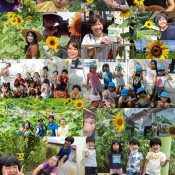
November 18, 2020 Ryukyu Shimpo
Across Japan, sunflowers from Kitanakagusuku have been blooming. Recently, one after another, people have been reporting that sunflowers have bloomed from sunflower seeds that were distributed free-of-charge in May by three people from a group for revitalizing the Kitanakagusuku Village region. Such joyful reports started around July, and are continuing to come in as of November. The three who distributed these seeds happily stated “We started, thinking that we wanted to help others feel encouraged during the coronavirus crisis, but rather we are the ones being encouraged by others from across the country.”
In an average year, the earliest sunflower festival in Japan is held in late February in Atsuta, Kitanakagusuku Village. However, since the festival was suspended, seeds were distributed free-of-charge.
About 200 bags of seeds were mailed within and outside of Okinawa, and Kitanakagusuku Village began to hear successive reports of the sunflowers, such as “Okinawa’s sunflowers are big” (woman in her 40s in Tokyo) and “They grew up to be 3 meters and 60 centimeters” (man in his 70s in Gunma).
However, on the questionnaire that came enclosed with the seeds, about half of respondents answered that they did not know of Kitanakagusuku Village.
The organizer of the group for revitalizing the Kitanakagusuku Village region, Takashi Yoshida, 34, said “There have been comments about wanting to try to come to Kitanakagusuku, and this inspires me to let others know about Kitanakagusuku and its many charms.”
(English translation by T&CT and Erin Jones)
Go to Japanese
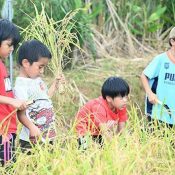
November 19, 2020 Ryukyu Shimpo
On November 7, young members of the Deigo Rugby Football School, lead by Shingo Mekaru, visited a farm in Goga, Nago City, to experience rice harvesting. Twenty-one 1st-3rd graders used sickles to harvest approximately 20 kg of mochi rice.
The activity aims to educate children on food and nutrition. Mekaru explained, “I wanted the children to see how the food they eat is made.” Many of the children had never used a sickle before and learned the techniques from their skilled peers. Mekaru watched on as he said, “The kids teaching each other [the techniques] is the same as how we practice rugby.” Kiko Funakoshi, a first-grade student at Yabu Elementary School, shared: “I was good at using the sickle.”
Sojun Kano, who offered his rice paddy for the activity, said, “Modern society is dominated by virtual [experiences]. I’m happy the children got to see where their food is made.”
(English translation by T&CT and Monica Shingaki)
Go to Japanese













 Webcam(Kokusai Street)
Webcam(Kokusai Street)


